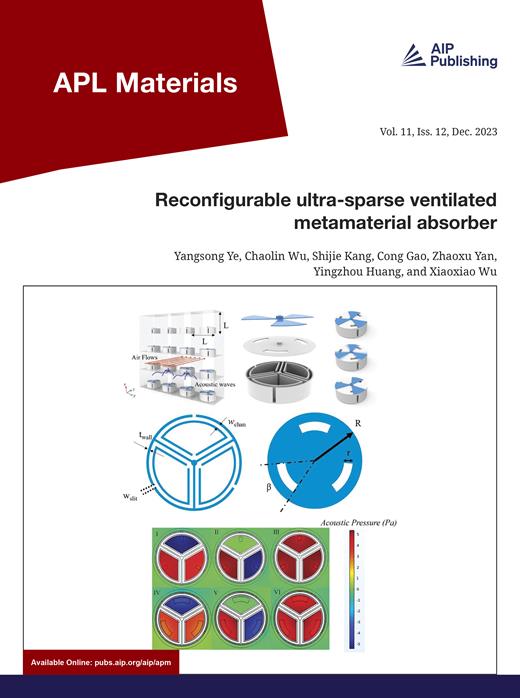Investigation of transverse exchange-springs in electrodeposited nano-heterostructured films through first-order reversal curve analysis
IF 5.3
2区 材料科学
Q2 MATERIALS SCIENCE, MULTIDISCIPLINARY
引用次数: 0
Abstract
The prerequisite of efficient exchange-spring nano-heterostructures, i.e., tuning both hard and soft phases at a nanometer level, has posed significant preparation challenges to ensure effective exchange-coupling. Here, we present a novel approach to fabricate transverse exchange-spring nano-heterostructures using single starting material through an “in situ” electrodeposition technique at room temperature. Utilizing modified acidic bath chemistry and controlled hydrogen evolution, we successfully prepared stress-free, shiny, fine-grained amorphous, and nanocrystalline Co-rich cobalt phosphorus films. These nano-heterostructured films exhibit a unique non-collinear anisotropy-driven transverse exchange-spring behavior, investigated systematically under ambient conditions. The comprehensive functional analyses reveal that intricate interplay between in-plane (IP) anisotropy of amorphous phase and out-of-plane (OOP) anisotropy generating from a nanocrystalline structure compete with each other, while producing characteristic stripe domain structures to novel corrugated stripe domain shapes. The angle-dependent first-order reversal curve distributions demonstrate new insights into the magnetic reversal mechanisms, further confirming the non-exchange-spring and exchange-spring nature of the films depending on the prevalent interfacial exchange coupling. Formation of anisotropy-driven metastable-state due to competition between IP and OOP anisotropy at a particular OOP orientation has led the normal exchange-spring structures to a transverse exchange-spring structure. Micromagnetic simulations, in excellent agreement with experimental data, further elucidate the formation of characteristic stripe domain patterns and the influence of anisotropy on the magnetic properties. The innovative methodology and detailed functional analysis presented here offer significant understanding to the field of exchange-spring magnetic materials, including anisotropy-driven metastable states, demonstrating the potential for scalable and cost-effective fabrication of advanced nano-heterostructures with tailored magnetic properties.通过一阶反转曲线分析研究电沉积纳米异质结构薄膜中的横向交换弹簧
高效交换弹簧纳米异质结构的先决条件是在纳米级水平上调整软硬两相,这为确保有效的交换耦合带来了巨大的制备挑战。在这里,我们提出了一种在室温下通过 "原位 "电沉积技术使用单一起始材料制造横向交换弹簧纳米异质结构的新方法。利用改良的酸性浴化学和受控的氢进化,我们成功制备出了无应力、有光泽、细粒度的非晶和纳米晶富钴磷薄膜。我们在环境条件下对这些纳米异质结构薄膜进行了系统研究,发现它们表现出独特的非共线各向异性驱动的横向交换弹簧行为。综合函数分析表明,非晶相的面内(IP)各向异性与纳米晶结构产生的面外(OOP)各向异性之间存在着错综复杂的相互作用,两者相互竞争,同时产生了从特征条纹畴结构到新型波纹条纹畴形状的变化。与角度相关的一阶反转曲线分布展示了对磁反转机制的新认识,进一步证实了薄膜的非交换弹簧和交换弹簧性质取决于普遍存在的界面交换耦合。在特定的 OOP 方向上,由于 IP 和 OOP 各向异性之间的竞争,形成了各向异性驱动的蜕变态,从而使正常的交换弹簧结构转变为横向交换弹簧结构。微磁模拟与实验数据非常吻合,进一步阐明了特征条纹畴模式的形成以及各向异性对磁性能的影响。本文介绍的创新方法和详细的功能分析为交换弹簧磁性材料领域(包括各向异性驱动的陨变态)提供了重要的认识,展示了以可扩展和具有成本效益的方式制造具有定制磁性能的先进纳米异质结构的潜力。
本文章由计算机程序翻译,如有差异,请以英文原文为准。
求助全文
约1分钟内获得全文
求助全文
来源期刊

APL Materials
NANOSCIENCE & NANOTECHNOLOGYMATERIALS SCIE-MATERIALS SCIENCE, MULTIDISCIPLINARY
CiteScore
9.60
自引率
3.30%
发文量
199
审稿时长
2 months
期刊介绍:
APL Materials features original, experimental research on significant topical issues within the field of materials science. In order to highlight research at the forefront of materials science, emphasis is given to the quality and timeliness of the work. The journal considers theory or calculation when the work is particularly timely and relevant to applications.
In addition to regular articles, the journal also publishes Special Topics, which report on cutting-edge areas in materials science, such as Perovskite Solar Cells, 2D Materials, and Beyond Lithium Ion Batteries.
 求助内容:
求助内容: 应助结果提醒方式:
应助结果提醒方式:


